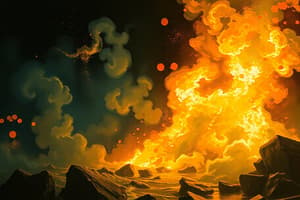Podcast
Questions and Answers
What is the purpose of balancing a chemical equation?
What is the purpose of balancing a chemical equation?
The purpose of balancing a chemical equation is to ensure that the number of atoms on both sides of the equation is equal.
What is an exothermic reaction?
What is an exothermic reaction?
An exothermic reaction is a chemical reaction that releases energy in the form of light, heat, or sound.
What is an endothermic reaction?
What is an endothermic reaction?
An endothermic reaction is a chemical reaction that absorbs or takes in heat.
How can you determine if a combustion reaction is exothermic?
How can you determine if a combustion reaction is exothermic?
What are the products of a combustion reaction?
What are the products of a combustion reaction?
How do you balance a combustion reaction?
How do you balance a combustion reaction?
What is the difference between bond-making and bond-breaking processes?
What is the difference between bond-making and bond-breaking processes?
How do you determine the final energy of a reaction?
How do you determine the final energy of a reaction?
What is a combustion reaction?
What is a combustion reaction?
What is the second reactant in a combustion reaction?
What is the second reactant in a combustion reaction?
What are the products of a combustion reaction?
What are the products of a combustion reaction?
How can you balance a combustion reaction?
How can you balance a combustion reaction?
How do you balance the oxygen atoms in a combustion reaction?
How do you balance the oxygen atoms in a combustion reaction?
How do you balance the carbon atoms in a combustion reaction?
How do you balance the carbon atoms in a combustion reaction?
What is the difference between an endothermic and exothermic reaction?
What is the difference between an endothermic and exothermic reaction?
What is a combustion reaction?
What is a combustion reaction?
What are the reactants in a combustion reaction?
What are the reactants in a combustion reaction?
What are the products of a combustion reaction?
What are the products of a combustion reaction?
How can you balance a combustion reaction equation?
How can you balance a combustion reaction equation?
What is the purpose of adding coefficients in front of the molecules in a balanced equation?
What is the purpose of adding coefficients in front of the molecules in a balanced equation?
How do you balance the oxygen atoms in a combustion reaction equation?
How do you balance the oxygen atoms in a combustion reaction equation?
How do you balance the carbon atoms in a combustion reaction equation?
How do you balance the carbon atoms in a combustion reaction equation?
Flashcards are hidden until you start studying
Study Notes
Balancing Chemical Equations
- Balancing ensures the law of conservation of mass is followed, meaning the number of atoms for each element is equal on both sides of the equation.
- Coefficients are used to adjust the number of molecules involved in the reaction without changing the nature of the substances.
Exothermic and Endothermic Reactions
- An exothermic reaction releases energy, typically in the form of heat, into the surroundings.
- An endothermic reaction absorbs energy from the surroundings, resulting in a drop in temperature.
Combustion Reactions
- A combustion reaction involves a substance (usually hydrocarbons) reacting with oxygen to produce energy, carbon dioxide, and water as products.
- Common reactants in combustion reactions include hydrocarbons and oxygen (O2).
Identifying Exothermic Combustion
- Combustion reactions are determined to be exothermic if they release energy, evident through a temperature increase or the production of light and heat.
Products of Combustion Reactions
- The primary products of a complete combustion reaction are carbon dioxide (CO2) and water (H2O).
- Incomplete combustion may produce carbon monoxide (CO) and soot (carbon particles).
Balancing Combustion Reactions
- To balance, start with carbon, then hydrogen, and finally oxygen.
- Balance carbon atoms first by matching the number of carbon atoms in the products with those in the reactants.
- Balance hydrogen atoms next, ensuring the hydrogen in products matches that in reactants.
- Oxygen atoms are balanced last, often requiring the use of fractional coefficients that can be converted into whole numbers.
Bond-Making vs. Bond-Breaking
- Bond-breaking is an endothermic process where energy is required to break bonds in reactants.
- Bond-making is an exothermic process where energy is released when bonds form in products.
Determining Final Energy of a Reaction
- The final energy can be determined by comparing the energy needed for bond-breaking in reactants and the energy released from bond-making in products.
Reactants and Products in Combustion
- The key reactants are typically hydrocarbons and oxygen.
- The products are carbon dioxide and water in complete combustion; potential byproducts could include carbon monoxide and particulate matter in incomplete combustion.
Balancing Oxygen and Carbon in Combustion Reactions
- Balance oxygen by counting oxygen atoms in products and adjusting coefficients to match reactants.
- Ensure carbon atoms in products equal those in reactants by adjusting the hydrocarbon coefficient accordingly.
Studying That Suits You
Use AI to generate personalized quizzes and flashcards to suit your learning preferences.




